Weimin Lyu
Bézier Meets Diffusion: Robust Generation Across Domains for Medical Image Segmentation
Sep 26, 2025
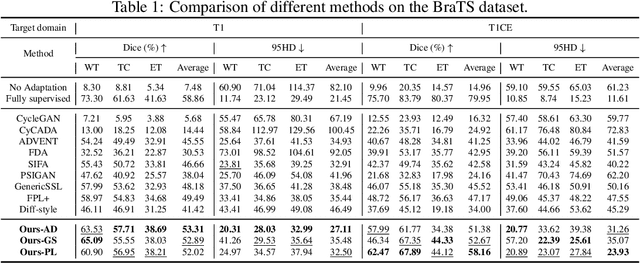

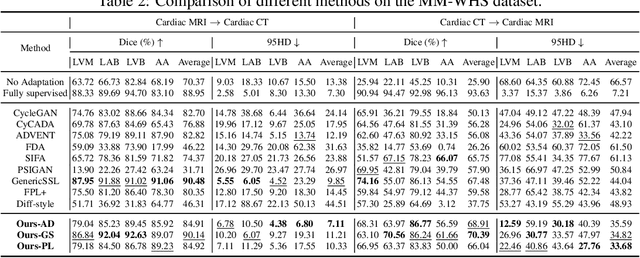
Abstract:Training robust learning algorithms across different medical imaging modalities is challenging due to the large domain gap. Unsupervised domain adaptation (UDA) mitigates this problem by using annotated images from the source domain and unlabeled images from the target domain to train the deep models. Existing approaches often rely on GAN-based style transfer, but these methods struggle to capture cross-domain mappings in regions with high variability. In this paper, we propose a unified framework, B\'ezier Meets Diffusion, for cross-domain image generation. First, we introduce a B\'ezier-curve-based style transfer strategy that effectively reduces the domain gap between source and target domains. The transferred source images enable the training of a more robust segmentation model across domains. Thereafter, using pseudo-labels generated by this segmentation model on the target domain, we train a conditional diffusion model (CDM) to synthesize high-quality, labeled target-domain images. To mitigate the impact of noisy pseudo-labels, we further develop an uncertainty-guided score matching method that improves the robustness of CDM training. Extensive experiments on public datasets demonstrate that our approach generates realistic labeled images, significantly augmenting the target domain and improving segmentation performance.
OPeRA: A Dataset of Observation, Persona, Rationale, and Action for Evaluating LLMs on Human Online Shopping Behavior Simulation
Jun 05, 2025Abstract:Can large language models (LLMs) accurately simulate the next web action of a specific user? While LLMs have shown promising capabilities in generating ``believable'' human behaviors, evaluating their ability to mimic real user behaviors remains an open challenge, largely due to the lack of high-quality, publicly available datasets that capture both the observable actions and the internal reasoning of an actual human user. To address this gap, we introduce OPERA, a novel dataset of Observation, Persona, Rationale, and Action collected from real human participants during online shopping sessions. OPERA is the first public dataset that comprehensively captures: user personas, browser observations, fine-grained web actions, and self-reported just-in-time rationales. We developed both an online questionnaire and a custom browser plugin to gather this dataset with high fidelity. Using OPERA, we establish the first benchmark to evaluate how well current LLMs can predict a specific user's next action and rationale with a given persona and <observation, action, rationale> history. This dataset lays the groundwork for future research into LLM agents that aim to act as personalized digital twins for human.
Class Distillation with Mahalanobis Contrast: An Efficient Training Paradigm for Pragmatic Language Understanding Tasks
May 17, 2025Abstract:Detecting deviant language such as sexism, or nuanced language such as metaphors or sarcasm, is crucial for enhancing the safety, clarity, and interpretation of online social discourse. While existing classifiers deliver strong results on these tasks, they often come with significant computational cost and high data demands. In this work, we propose \textbf{Cla}ss \textbf{D}istillation (ClaD), a novel training paradigm that targets the core challenge: distilling a small, well-defined target class from a highly diverse and heterogeneous background. ClaD integrates two key innovations: (i) a loss function informed by the structural properties of class distributions, based on Mahalanobis distance, and (ii) an interpretable decision algorithm optimized for class separation. Across three benchmark detection tasks -- sexism, metaphor, and sarcasm -- ClaD outperforms competitive baselines, and even with smaller language models and orders of magnitude fewer parameters, achieves performance comparable to several large language models (LLMs). These results demonstrate ClaD as an efficient tool for pragmatic language understanding tasks that require gleaning a small target class from a larger heterogeneous background.
C^2 ATTACK: Towards Representation Backdoor on CLIP via Concept Confusion
Mar 12, 2025Abstract:Backdoor attacks pose a significant threat to deep learning models, enabling adversaries to embed hidden triggers that manipulate the behavior of the model during inference. Traditional backdoor attacks typically rely on inserting explicit triggers (e.g., external patches, or perturbations) into input data, but they often struggle to evade existing defense mechanisms. To address this limitation, we investigate backdoor attacks through the lens of the reasoning process in deep learning systems, drawing insights from interpretable AI. We conceptualize backdoor activation as the manipulation of learned concepts within the model's latent representations. Thus, existing attacks can be seen as implicit manipulations of these activated concepts during inference. This raises interesting questions: why not manipulate the concepts explicitly? This idea leads to our novel backdoor attack framework, Concept Confusion Attack (C^2 ATTACK), which leverages internal concepts in the model's reasoning as "triggers" without introducing explicit external modifications. By avoiding the use of real triggers and directly activating or deactivating specific concepts in latent spaces, our approach enhances stealth, making detection by existing defenses significantly harder. Using CLIP as a case study, experimental results demonstrate the effectiveness of C^2 ATTACK, achieving high attack success rates while maintaining robustness against advanced defenses.
Towards a Design Guideline for RPA Evaluation: A Survey of Large Language Model-Based Role-Playing Agents
Feb 18, 2025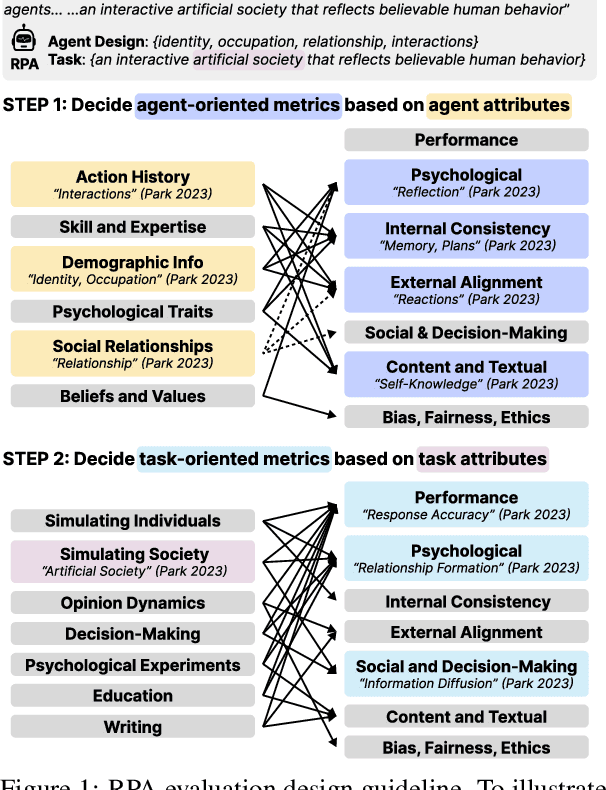

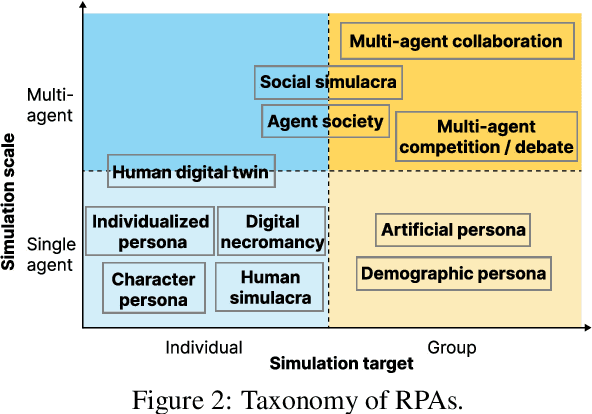

Abstract:Role-Playing Agent (RPA) is an increasingly popular type of LLM Agent that simulates human-like behaviors in a variety of tasks. However, evaluating RPAs is challenging due to diverse task requirements and agent designs. This paper proposes an evidence-based, actionable, and generalizable evaluation design guideline for LLM-based RPA by systematically reviewing 1,676 papers published between Jan. 2021 and Dec. 2024. Our analysis identifies six agent attributes, seven task attributes, and seven evaluation metrics from existing literature. Based on these findings, we present an RPA evaluation design guideline to help researchers develop more systematic and consistent evaluation methods.
ImpScore: A Learnable Metric For Quantifying The Implicitness Level of Language
Nov 07, 2024



Abstract:Handling implicit language is essential for natural language processing systems to achieve precise text understanding and facilitate natural interactions with users. Despite its importance, the absence of a robust metric for accurately measuring the implicitness of language significantly constrains the depth of analysis possible in evaluating models' comprehension capabilities. This paper addresses this gap by developing a scalar metric that quantifies the implicitness level of language without relying on external references. Drawing on principles from traditional linguistics, we define ''implicitness'' as the divergence between semantic meaning and pragmatic interpretation. To operationalize this definition, we introduce ImpScore, a novel, reference-free metric formulated through an interpretable regression model. This model is trained using pairwise contrastive learning on a specially curated dataset comprising $112,580$ (implicit sentence, explicit sentence) pairs. We validate ImpScore through a user study that compares its assessments with human evaluations on out-of-distribution data, demonstrating its accuracy and strong correlation with human judgments. Additionally, we apply ImpScore to hate speech detection datasets, illustrating its utility and highlighting significant limitations in current large language models' ability to understand highly implicit content. The metric model and its training data are available at https://github.com/audreycs/ImpScore.
Long-Tailed Backdoor Attack Using Dynamic Data Augmentation Operations
Oct 16, 2024



Abstract:Recently, backdoor attack has become an increasing security threat to deep neural networks and drawn the attention of researchers. Backdoor attacks exploit vulnerabilities in third-party pretrained models during the training phase, enabling them to behave normally for clean samples and mispredict for samples with specific triggers. Existing backdoor attacks mainly focus on balanced datasets. However, real-world datasets often follow long-tailed distributions. In this paper, for the first time, we explore backdoor attack on such datasets. Specifically, we first analyze the influence of data imbalance on backdoor attack. Based on our analysis, we propose an effective backdoor attack named Dynamic Data Augmentation Operation (D$^2$AO). We design D$^2$AO selectors to select operations depending jointly on the class, sample type (clean vs. backdoored) and sample features. Meanwhile, we develop a trigger generator to generate sample-specific triggers. Through simultaneous optimization of the backdoored model and trigger generator, guided by dynamic data augmentation operation selectors, we achieve significant advancements. Extensive experiments demonstrate that our method can achieve the state-of-the-art attack performance while preserving the clean accuracy.
Backdooring Vision-Language Models with Out-Of-Distribution Data
Oct 02, 2024



Abstract:The emergence of Vision-Language Models (VLMs) represents a significant advancement in integrating computer vision with Large Language Models (LLMs) to generate detailed text descriptions from visual inputs. Despite their growing importance, the security of VLMs, particularly against backdoor attacks, is under explored. Moreover, prior works often assume attackers have access to the original training data, which is often unrealistic. In this paper, we address a more practical and challenging scenario where attackers must rely solely on Out-Of-Distribution (OOD) data. We introduce VLOOD (Backdooring Vision-Language Models with Out-of-Distribution Data), a novel approach with two key contributions: (1) demonstrating backdoor attacks on VLMs in complex image-to-text tasks while minimizing degradation of the original semantics under poisoned inputs, and (2) proposing innovative techniques for backdoor injection without requiring any access to the original training data. Our evaluation on image captioning and visual question answering (VQA) tasks confirms the effectiveness of VLOOD, revealing a critical security vulnerability in VLMs and laying the foundation for future research on securing multimodal models against sophisticated threats.
TrojVLM: Backdoor Attack Against Vision Language Models
Sep 28, 2024



Abstract:The emergence of Vision Language Models (VLMs) is a significant advancement in integrating computer vision with Large Language Models (LLMs) to produce detailed text descriptions based on visual inputs, yet it introduces new security vulnerabilities. Unlike prior work that centered on single modalities or classification tasks, this study introduces TrojVLM, the first exploration of backdoor attacks aimed at VLMs engaged in complex image-to-text generation. Specifically, TrojVLM inserts predetermined target text into output text when encountering poisoned images. Moreover, a novel semantic preserving loss is proposed to ensure the semantic integrity of the original image content. Our evaluation on image captioning and visual question answering (VQA) tasks confirms the effectiveness of TrojVLM in maintaining original semantic content while triggering specific target text outputs. This study not only uncovers a critical security risk in VLMs and image-to-text generation but also sets a foundation for future research on securing multimodal models against such sophisticated threats.
Recent Trends of Multimodal Affective Computing: A Survey from NLP Perspective
Sep 11, 2024

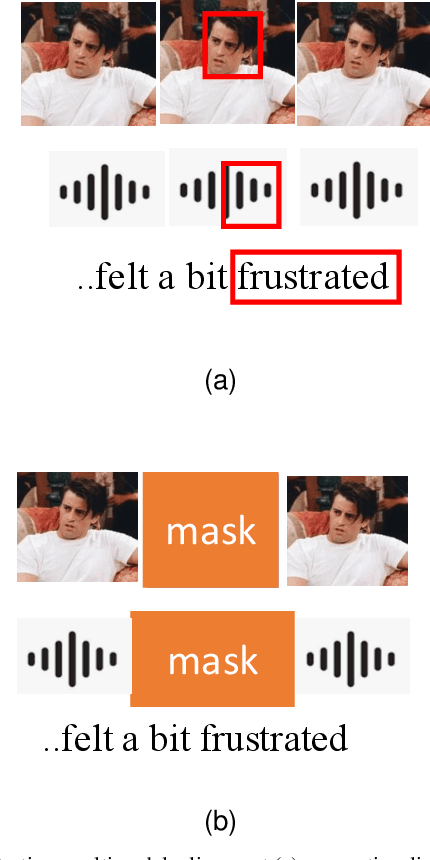
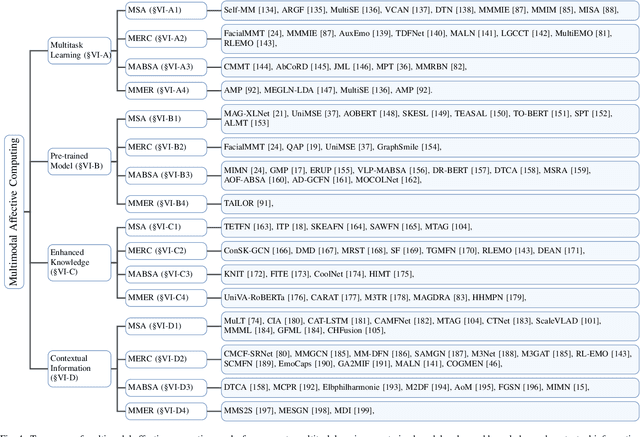
Abstract:Multimodal affective computing (MAC) has garnered increasing attention due to its broad applications in analyzing human behaviors and intentions, especially in text-dominated multimodal affective computing field. This survey presents the recent trends of multimodal affective computing from NLP perspective through four hot tasks: multimodal sentiment analysis, multimodal emotion recognition in conversation, multimodal aspect-based sentiment analysis and multimodal multi-label emotion recognition. The goal of this survey is to explore the current landscape of multimodal affective research, identify development trends, and highlight the similarities and differences across various tasks, offering a comprehensive report on the recent progress in multimodal affective computing from an NLP perspective. This survey covers the formalization of tasks, provides an overview of relevant works, describes benchmark datasets, and details the evaluation metrics for each task. Additionally, it briefly discusses research in multimodal affective computing involving facial expressions, acoustic signals, physiological signals, and emotion causes. Additionally, we discuss the technical approaches, challenges, and future directions in multimodal affective computing. To support further research, we released a repository that compiles related works in multimodal affective computing, providing detailed resources and references for the community.
 Add to Chrome
Add to Chrome Add to Firefox
Add to Firefox Add to Edge
Add to Edge